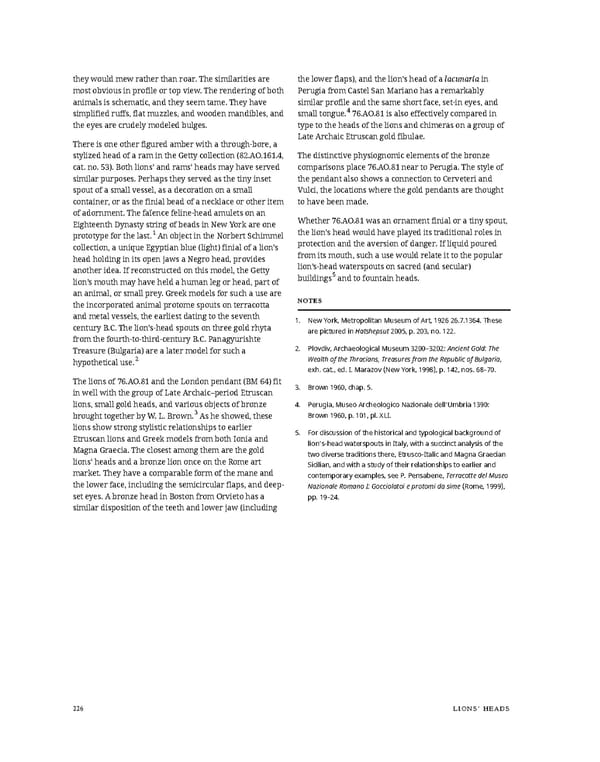they would mew rather than roar. The similarities are the lower flaps), and the lion’s head of a lacunaria in most obvious in profile or top view. The rendering of both Perugia from Castel San Mariano has a remarkably animals is schematic, and they seem tame. They have similar profile and the same short face, set-in eyes, and simplified ruffs, flat muzzles, and wooden mandibles, and small tongue.4 76.AO.81 is also effectively compared in the eyes are crudely modeled bulges. type to the heads of the lions and chimeras on a group of Late Archaic Etruscan gold fibulae. There is one other figured amber with a through-bore, a stylized head of a ram in the Getty collection (82.AO.161.4, The distinctive physiognomic elements of the bronze cat. no. 53). Both lions’ and rams’ heads may have served comparisons place 76.AO.81 near to Perugia. The style of similar purposes. Perhaps they served as the tiny inset the pendant also shows a connection to Cerveteri and spout of a small vessel, as a decoration on a small Vulci, the locations where the gold pendants are thought container, or as the finial bead of a necklace or other item to have been made. of adornment. The faïence feline-head amulets on an Eighteenth Dynasty string of beads in New York are one Whether 76.AO.81 was an ornament finial or a tiny spout, prototype for the last.1 An object in the Norbert Schimmel the lion’s head would have played its traditional roles in collection, a unique Egyptian blue (light) finial of a lion’s protection and the aversion of danger. If liquid poured head holding in its open jaws a Negro head, provides from its mouth, such a use would relate it to the popular another idea. If reconstructed on this model, the Getty lion’s-head waterspouts on sacred (and secular) buildings5 and to fountain heads. lion’s mouth may have held a human leg or head, part of an animal, or small prey. Greek models for such a use are NOTES the incorporated animal protome spouts on terracotta and metal vessels, the earliest dating to the seventh 1. New York, Metropolitan Museum of Art, 1926 26.7.1364. These century B.C. The lion’s-head spouts on three gold rhyta are pictured in Hatshepsut 2005, p. 203, no. 122. from the fourth-to-third-century B.C. Panagyurishte Treasure (Bulgaria) are a later model for such a 2. Plovdiv, Archaeological Museum 3200–3202: Ancient Gold: The hypothetical use.2 Wealth of the Thracians, Treasures from the Republic of Bulgaria, exh. cat., ed. I. Marazov (New York, 1998), p. 142, nos. 68–70. The lions of 76.AO.81 and the London pendant (BM 64) fit 3. Brown 1960, chap. 5. in well with the group of Late Archaic–period Etruscan lions, small gold heads, and various objects of bronze 4. Perugia, Museo Archeologico Nazionale dell’Umbria 1390: brought together by W. L. Brown.3 As he showed, these Brown 1960, p. 101, pl. XLI. lions show strong stylistic relationships to earlier 5. For discussion of the historical and typological background of Etruscan lions and Greek models from both Ionia and lion’s-head waterspouts in Italy, with a succinct analysis of the Magna Graecia. The closest among them are the gold two diverse traditions there, Etrusco-Italic and Magna Graecian lions’ heads and a bronze lion once on the Rome art Sicilian, and with a study of their relationships to earlier and market. They have a comparable form of the mane and contemporary examples, see P. Pensabene, Terracotte del Museo the lower face, including the semicircular flaps, and deep- Nazionale Romano I: Gocciolatoi e protomi da sime (Rome, 1999), set eyes. A bronze head in Boston from Orvieto has a pp. 19–24. similar disposition of the teeth and lower jaw (including 226 LIONS’ HEADS
 Ancient Carved Ambers in the J. Paul Getty Museum Page 235 Page 237
Ancient Carved Ambers in the J. Paul Getty Museum Page 235 Page 237